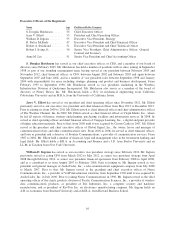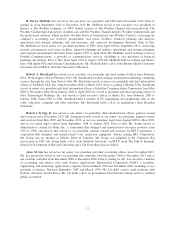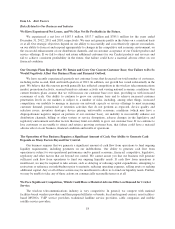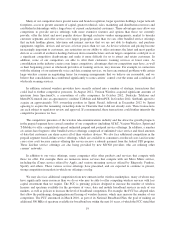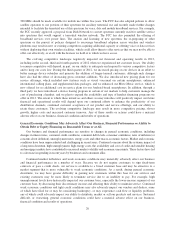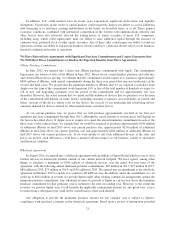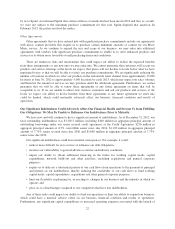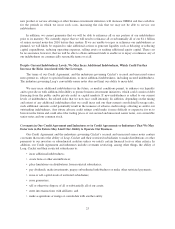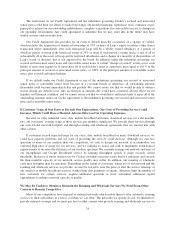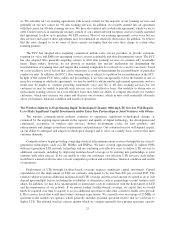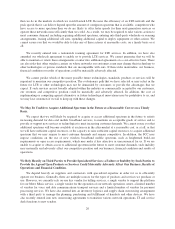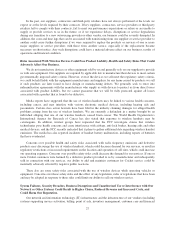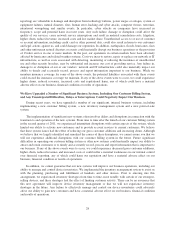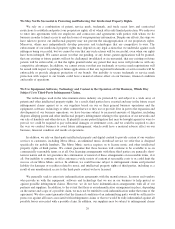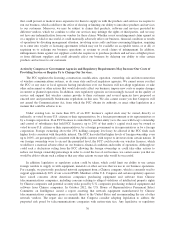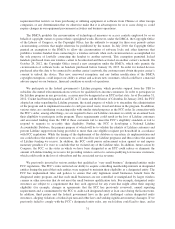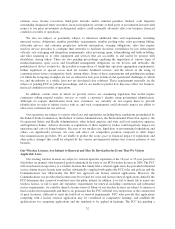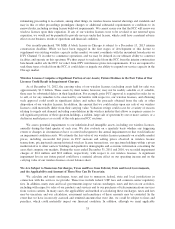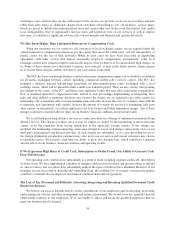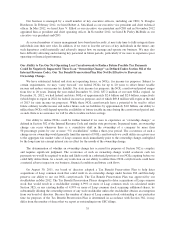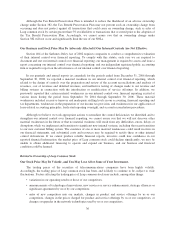Cricket Wireless 2012 Annual Report Download - page 40
Download and view the complete annual report
Please find page 40 of the 2012 Cricket Wireless annual report below. You can navigate through the pages in the report by either clicking on the pages listed below, or by using the keyword search tool below to find specific information within the annual report.than we do in the markets in which we would launch LTE. Because the efficiency of an LTE network and the
peak speeds that it can deliver depend upon the amount of contiguous spectrum that is available, competitors who
have access to more spectrum than we do are likely to offer faster speeds for their next-generation services or
operate those networks more efficiently than we could. As a result, we may be required to take various actions to
meet consumer demand, including acquiring additional spectrum, entering into third-party wholesale or roaming
arrangements, leasing additional cell sites, spending additional capital to deploy equipment or other actions. We
cannot assure you that we would be able to take any of these actions at reasonable costs, on a timely basis or at
all.
We recently entered into a nationwide roaming agreement for LTE services. In addition, we have also
amended our wholesale agreement to enable us to provide LTE services. We cannot guarantee that we will be
able to maintain or renew these arrangements or enter into additional agreements on a cost-effective basis. There
are also risks that other wireless carriers on whose networks our customers roam may change their technology to
other technologies or pursue standards that are incompatible with ours. If these risks materialize, our business,
financial condition or results of operations could be materially adversely affected.
We cannot predict which of the many possible future technologies, standards, products or services will be
important to maintain our competitive position. The evolutionary path that we have selected or may select in the
future for LTE or other technologies may not be demanded by customers or provide the advantages that we
expect. If such services are not broadly adopted within the industry or commercially accepted by our customers,
our revenues and competitive position could be materially and adversely affected. In addition, the cost of
implementing or competing against alternative or future technological innovations may be prohibitive to us, and
we may lose customers if we fail to keep up with these changes.
We May Be Unable to Acquire Additional Spectrum in the Future at a Reasonable Cost or on a Timely
Basis.
We expect that we will likely be required to acquire or access additional spectrum in the future to satisfy
increasing demand for data and mobile broadband services, to maintain an acceptable grade of service and to
provide or support new services or technologies to meet increasing customer demands. We cannot assure you that
additional spectrum will become available at auction or in the after-market at a reasonable cost, or at all, or that
we will have sufficient capital resources, or the capacity to raise sufficient capital resources, to acquire additional
spectrum that we may require to meet customer demands and remain competitive. In addition, the FCC may
impose conditions on the use of new wireless broadband mobile spectrum, such as heightened build-out
requirements or open access requirements, which may make it less attractive or uneconomical for us. If we are
unable to acquire or obtain access to additional spectrum in the future to meet customer demands, such inability
may materially and adversely affect our competitive position and our business, financial condition and results of
operations.
We Rely Heavily on Third Parties to Provide Specialized Services; a Failure or Inability by Such Parties to
Provide the Agreed Upon Products or Services Could Materially Adversely Affect Our Business, Results of
Operations and Financial Condition.
We depend heavily on suppliers and contractors with specialized expertise in order for us to efficiently
operate our business. Generally, there are multiple sources for the types of products and services we purchase or
use. However, we currently rely on one key vendor for billing services, a single vendor to support the platform
for our Muve Music service, a single vendor for the operation of our network operations center, a limited number
of vendors for voice and data communications transport services and a limited number of vendors for payment
processing services. We have also entered into an inventory logistics and supply chain outsourcing arrangement
with a third party to manage the planning, purchasing and fulfillment of handsets and other devices. We have
also recently entered into new outsourcing agreements to transition various network operations, IT and service
desk functions to new vendors.
26


